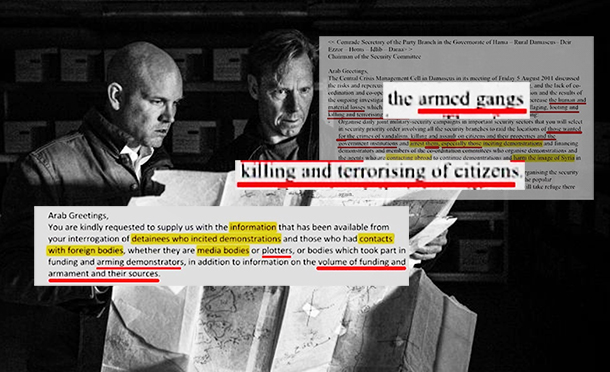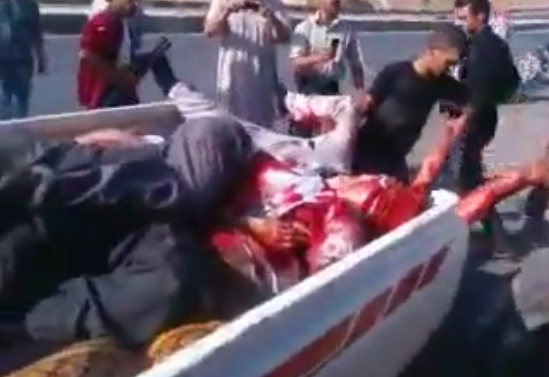
The “Assad Files” story: ‘A secretive team of war crimes investigators smuggled hundreds of thousands of documents out of Syria … to build a case against Assad.’ Upon closer examination though, this impressive trove of ‘evidence’ appears to vindicate, rather than condemn the Syrian government.
Adam Larson
21st Century Wire
As the Syrian government slowly regains its territory and sets to rebuilding from seven years of brutal conflict, we still lack an accurate picture of how the fighting began. We’ve been told of peaceful protests in 2011 that were ruthlessly crushed, forcing violent resistance instead. But it turns out this wasn’t totally true.
And now we have one more clear confirmation that picture was sanitized, distorting public perception to accept the continued targeting of Syria’s government. At the nexus the mainstream media and western-backed “war crimes” investigators, someone with some reality in front of them apparently chose to delete the important half of it, before promoting the rest nearly upside-down, as an important breakthrough in proving that other picture.
It’s claimed this piece of evidence is the “linchpin” of an incredibly strong case to be used in an eventual court trials against any Syrian officials deemed complicit. Maybe they plan on showing the judge the same select quotes they shared with the court public opinion in their long-running pre-trial. But if so, they had better hope that judge hasn’t read this article.
Managing a Crisis of… Just Protesters?
Just four months into the supposed protest-crushing, at the start of August, 2011, the increasingly isolated Syrian government decided a new plan was needed. To this end, they created a new “Central Crisis Management Cell” (CCMC). The first meeting of the CCMC was held in Damascus on August 5th, outlining a plan of action “to speed up putting an end to the crisis.”
A leaked record of this was later received by the Committee for International Justice and Accountability (CIJA), as part of their massive trove of documents commonly called, “The Assad Files.” The CIJA (funded by Western governments) and their allies allege these documents prove systematic crimes, perhaps more clearly than anything ‘since the Nuremberg trials.’
But still with some claimed 750,000 pages of leaked or seized top secret papers, and several years to dig through them, with numerous shared examples and select quotes meant to convince the public, the allegations remain far from proven. For example, torture is mentioned at least twice, as something that has happened in some facilities. The system is only seen stepping in to order that it be stopped. That’s actually counter-evidence for the systematic torture so widely alleged, but they don’t seem to have anything better just yet. Here is some addition background analysis on The Assad Files:
• New Yorker “Assad Files”: Multi Million Dollar Propaganda Campaign
• MSM Theatre: Claims of ‘800,000 Secret Documents About Assad’s War Crimes’
• Regarding Those “Assad Files” – What Ties What to What?
• Assad Files 2018, Part 2
The authenticity of the files is not certain, but if they’re fake, one would expect that they might contain more dirt than it seems they do. They might be more like the juicy apparent forgeries once “leaked” to Saudi-owned Al-Arabiya, but probably less obvious. One of those, for example, lays out a plot to kill the Grand Mufti’s son and frame “terrorists.” The man was killed, but almost certainly by real terrorists, between Idlib and Aleppo, on October 2, 2011.
Most likely, these papers the CIJA has are mainly or entirely genuine. But it seems only a lot of selective citation, spin, mood music, and distraction (switching to verbal stories or those ugly “Caesar photos”) can makes the case based on them seem so impressive.
 But more narrowly now, their evidence relating to the CCMC’s formation and mandate was shared – at least partially – with Ben Taub (image, left), a writer with The New Yorker, and appeared in his April, 2016 article entitled, “The Assad Files.” As explained, the crisis cell that night ordered “daily raids” and arrests of wanted persons, clearing and holding whole areas in coordination with locals, and a new joint investigation committee for each region to oversee “interrogation” of prisoners and share their intelligence.
But more narrowly now, their evidence relating to the CCMC’s formation and mandate was shared – at least partially – with Ben Taub (image, left), a writer with The New Yorker, and appeared in his April, 2016 article entitled, “The Assad Files.” As explained, the crisis cell that night ordered “daily raids” and arrests of wanted persons, clearing and holding whole areas in coordination with locals, and a new joint investigation committee for each region to oversee “interrogation” of prisoners and share their intelligence.
This process was followed with nightly meeting in a “drab” Baath Party office, Taub wrote, plotting the best “strategies for crushing dissent.” And it was only dissent, as presented. The “specific categories of people” the CCMC was after, who would be turned into those prisoners allegedly tortured to death in the thousands, were:
- “protest organizers” (paraphrased)
- “those who tarnish the image of Syria in foreign media” (direct quote).
No other categories are mentioned, in what sounds like the same crackdown on freedom we’ve been told of from the start. This was allegedly their main plan for the entire nation; shut those people up quick, and the crisis is resolved,
In fact, the CIJA considers the CCMC documents the “linchpin” of their case against officials, as Taub’s piece puts it. Lead investigator Bill Wiley found it easy to know which officials to prosecute for this repressive policy, because “their names are all over those documents.”
Writer Ben Taub won the Pulitzer Center’s RFK prize for journalism in 2017 for this work on “secret Assad regime files.” His report remains perhaps the most cited article on the subject, and was eagerly followed by others, like Emma Reynolds with her feature published at News.com.au, entitled, ‘There’s No Air. You’re Rotting’: Inside the Assad Files, who wrote about how the memos starting in August “paint a clear picture of how orders for what happened to people like Mazen al-Hamada came all the way from the top.” Hamada, a key witness in Taub’s story, claims he was arrested for smuggling baby formula to a woman in Daraya. But there has still been no evidence found in the “Assad files” relating to any baby formula embargo, and there’s really no reason to suspect one. For more details and context on Hamada’s testimony, see my earlier report, ‘Witness Assessment: Mazen Hamada’.
The Missing Militant Threat
That telling of the CCMC’s formation and mandate always seemed, at the very least, to lack some realistic features. As I noted at A Closer Look On Syria:
“It’s likely the named categories (“protest organizers and “those who tarnish the image of Syria in foreign media””) were targeted, but not exclusively. It’s a near-certainty that armed groups were discussed as the main concern […] But the main part is probably cut out […] it suggests Damascus had no concern with armed groups (because there were none?) as they worked on crushing peaceful protests.”
As some realize, there were militants, who launched many deadly attacks on security forces, starting just days into the protest-uprising that began in earnest on March 15, 2011. The slide to violence was instant, if not quicker. The most serious cases include these:
- Up to 60 soldiers were killed in an ambush in Daraa province at the end of March, but neither side wanted to report it at the time (Narwani).
- 10 soldiers were killed in an ambush in Baniyas on April 10th, and an Alawite farmer became the first civilian reported killed there the same day (MMM blog)
- An Alawite officer, a teenage son and two nephews were killed and mutilated near Homs, on April 17th (ACLOS)
- Some 120 or more soldiers and public servants were killed over several days in early June in an event that, like those above, was murky and disputed. (ACLOS).
There and some lesser and individual cases went buried in a larger and growing number of civilians killed in the first months, reportedly all by the government. But those claiming that also tended to blame the Syrian Arab Army (or “Hezbollah men”) for shooting its own soldiers in the above cases, for “refusing to shoot protesters.” This is always a dubious claim, and people with one kind of dubious claim might have more.
The most recent example prior to the CCMC’s founding was just a few days earlier, and inside one of Syria’s more central cities. 31 July witnessed protests in Hama, reportedly crushed with a record-breaking death toll, in a one-sided “massacre.” Al-Jazeera reported “at least 100 deaths in Hama, after tanks and soldiers stormed the city.” Meanwhile, “US President Barack Obama said he was appalled,” declaring “the reports out of Hama are horrifying and demonstrate the true character of the Syrian regime.” He “promised to work with others to isolate President Bashar al-Assad.” This would soon lead to the unified statements of August 18th demanding the Syrian president step down in some unclear “transition.”
However, by the preponderance of claims and evidences, the Hama death toll includes 26 members of the security forces killed by militants, in attacks on several locations (Hader police station, the officer’s club, and a coordinated mutiny in the central prison, at least).
But the bulk of the dead obscuring that was around 80 men and older boys, allegedly all civilian. That should include some unacknowledged fighters killed in their ambitious attacks, but probably not 80 or more of them. Any true civilians might have been killed by the same militants on the offensive that day. They might be chosen for their religion or support to the government, or just at random to inflate the death toll. It might also include innocents killed by the government, but it didn’t work to their favor if so. For more detail on this situation, see my earlier report, Deaths by Shooting: The Rebellion Begins in Hama, Part 1.
In the militant attack glossed over here, it seems some secret policemen were actually captured, executed later, and dumped in the Orontes river by people shouting Allahu Akbar. Part of this was seen on a published video geo-located to the outskirts of Hama, mid-morning on August 1st. Some had throats sliced. 8 bodies are seen dumped, and the government says they recovered a total of 13 (that’s half of the 26 total cited above, not in addition to it). Some opposition activists tried to deny this incident, but one activist confirmed it to CNN:
“The bodies are those of Syrian secret police killed by Syrian fighters from Iraq who have joined the anti-government fight, said the activist, who gets information about the goings-on in Syria from an extensive network of informants.”
That’s likely Osama Suleiman, aka ‘Rami Abdulrahman’ of the Syrian Observatory for Human Rights, but requesting anonymity on that subject at the time. What he describes is basically Al-Qaeda – future members of Jabhat al-Nusra and ISIS/Islamic State/Daesh, and the like. It seems they were killing government servants already in the summer of 2011, long before either group formally existed. No one seems to have connected this incident to the decried government massacre the day before, but it’s clearly an extension. It’s most likely these terrorists and just a bit of defensive fire that combined to hit that milestone of 100 dead in a day, leading to “Assad’s” increasing isolation by the “deeply concerned world community.”

Aug. 1, Hama: a bit of that “crisis” they talk about (Source: MMM Blog)
This event and those before should obviously go into shaping the thinking of Syrian officials in the first days of August, as they implemented thee CCMC and their new plan. It should be one to shut down militant networks and halt the bloodshed that increasingly threatened their own political survival. Yet we’re to believe their crisis response plan included only a crackdown on protest organizers and ‘image tarnishers’?
Very many people did believe that story, and it might make sense – if the government had indeed killed their own soldiers and everyone else so far. Publicly they’d blame “terrorists,” but if they saw no real militant threat, their secret plans might be to go after the disaffected protesters instead. They could send more soldiers… whom they may have to just have other soldiers shoot again.
This might seem absurd, but as we heard, top secret documents suggest just such a mindset was at work.
But we heard wrong.
Someone Deleted the Militants!
Later, Thanks to an online video from the English edition of Spanish paper El País in June, 2018, we can see a clear reflection of that “linchpin”. The video presents the Assad files to portray the regime’s brutality – alongside the “Caesar torture photos” and alleged prisoner stories, with mood music and quiet credulity, in a now-familiar formula. But it does show a memo dated the next day (August 6th) and referring to the CCMC meeting in question, relating the same concerns and plans mentioned in Ben Taub’s report. This isn’t exactly from the meeting, but should reflect all its main points.
In this video we can see it scrolling across the screen, the whole page translated to English, and the Arabic original to a lesser degree. A partial check suggests the given translation is at least basically correct (see here for a little more detail, and note it still could use more analysis). We’ll just use the English here. Below is the header and first paragraphs, with yellow highlighting by El País, and red underlining added by me for important context previously omitted.

For more detail on the El País exposé, see my previous report, ‘Painting Vs. Reality in Syria Crisis Response’.
This was originally an August 6th memo, discussing the previous day’s CCMC charter meeting. It was sent to regional Baath party officers in several areas known to have suffered violence, with Hama listed first (perhaps reflecting recent events there). It does mention demonstrations and demonstrators four times, in the section on who to arrest. But this memo also mentions “armed gangs” that cause “human and material losses” by:
- “vandalism”
- “looting”
- “pillaging”
- “attacking state institutions”
- “killing and terrorizing citizens.”
As they said in secret, this harsh reality necessitated so-called “security operations.” Those were expected to incur “losses,” perhaps related to the weapons they hoped to seize some of. They also decided some soldiers had a way of losing their weapons to, or being “reluctant” to fight, the “armed groups.” These might be sympathizers, possibly defectors willing to kill their fellow soldiers, like at Jisr al-Shughour. They wanted to know in advance who these might be. That sounds reasonable.
This is a direct reflection of the CIJA’s “linchpin” proving repression, and it explains those to arrest are actually “wanted for the crimes of vandalism, killing, and assault on citizens and their properties and the government institutions.” Among those violent people – not in addition to them, and not instead of them – they wanted “especially those” who were also involved in inciting or funding “demonstrations.” But as another document in the El País video shows, it’s a type of demonstrations that involves “funding and armaments” thought to originate from abroad (or at least somewhere unknown).

The very definition of “demonstrations” used here seems a bit different from usual, with weapons being involved. Perhaps they mean staged protests at which mysterious gunmen shoot people and blame the government, thus “harming their image” in videos aired on foreign media. Any aspect of such a machine would be shut down if possible, by any government.
Specifically they wanted member of the Local Coordinating Committees (LCC), militant-linked propaganda activists. These were central to the early uprising, organizing protests and disseminating dozens of videos daily, alleging only “regime” crimes and denying any on the opposition side. For example, the LCC claimed the Hama incident with policemen dumped in the river was a hoax, arguing there was no such bridge in Hama, when in fact there definitely is. For more detailed analysis of this point, see my report ‘Deaths by Shooting The Rebellion Begins in Hama, Part 1‘.
So the wanted “protester organizers” in The New Yorker’s story were militants also engaged in deadly mayhem and propaganda to cover for that. The Syrian security apparatus was focused on these, as if they really were behind much or most of the violence, or at least the killing of their own soldiers. Any government would shut down militants who were killing their security forces. That’s not remotely criminal.
I asked Ben Taub about the details missing in his article, but so far he has not responded. It’s not clear if he or – more likely – the CIJA made the decision to delete the militants and distort this evidence. But someone did.
@bentaub91 I should finally ask the author: Assad Files article, 2016: any idea how the red-underlined parts here went missing in your article's version of this "linchpin"? It seems to be a plan to stop "armed groups" killing people. https://t.co/bk0LpDfOCL pic.twitter.com/3o8hmDxhsd
— Adam Larson (@CL4Syr) September 27, 2018
In summary: We hear these impressive top-secret files – plus the infamous “Caesar torture photos” and a lot of verbal stories, all leaning on each other – constitutes the strongest evidence of crimes against humanity since Nuremberg (or at least pretty good-seeming evidence of something vaguely Holocaust-like). And there’s this “linchpin” in the center of the paperwork sector, tying it together.
SEE ALSO: The “Caesar” Fraud That Undermined Syrian Peace Negotiations
However, it turns out that was actually a reasonable plan to stop the “killing and terrorizing” of Syrian citizens. But government officials some want regime-changed into oblivion have their names “all over those documents,” as CIJA’s Bill Wiley put it. And that’s probably just why someone cut out the adverse reality, turning that plan into some kind of vague and illogical crime against humanity – a gross and unethical distortion. Are the selected investigators here not so much driven by the truth as driven through it like a snowplow?
This is just one point and might seem insignificant compared to the masses of widely agreed stories of regime atrocities. But it emerges at a rare point where can check the claims and get an unusually clear answer. The bulk of allegations we can’t verify – are they by chance way more honest than this? Or is that consensus on blaming “Assad” based on a whole lot of distortions like this? Can it be some kind of truth-averse agenda drives work like this, and that of so many influential people all “confirming” each other as to appear almost like universal truth?
P.S. For an optional bit of extra depth, consider a March, 2018 MSNBC report from Richard Engel (one of the network’s star reports who of course, has a dubious record on truthful reporting in Syria). This cites a document from the Idlib Police Command dated October, 16, 2011, about “dozens” of detainees pleading guilty to simply “protesting against the Assad government.” But analysis of the partial view shows the document cites “protesting w–” (without a permit? it cuts off about two words.) And they were also – seen but not mentioned – guilty of “vandalizing public properties,” and apparently nothing more serious.
(Side-note: more serious crimes were occurring, of course. Someone murdered the Grand Mufti’s son Sariya, as note above, two weeks earlier in the same general area.)
Richard Engel MSNBC adds to #AssadFiles record: 16-10-2011 admission (under torture?) to protesting. (w/o permit?) And also vandalism. then tortured to death? Neat story. https://t.co/uZppbYeoxX pic.twitter.com/jwQWHVcaYg
— Adam Larson (@CL4Syr) October 7, 2018
CIJA investigator Chris Engels affirms these admissions were given either under torture, or threat of it. But it hardly seems worth the effort for such petty confessions, and strong evidence might also have been involved. The fates of these men are not explained; perhaps they suffered horrible deaths under more torture, or maybe they lived a more boring story of short sentences, followed by release.
It is important to note the basis of Western policy against Syria is based on the idea that the regime was responsible for the “civil war,” the refugee crisis, and maybe even the rise of ISIS/Islamic State. Certainly, this is the primary basis for the dual US-EU sanctions and economic embargo and calls for ‘regime change’ in Syria that continues to this day. Despite ample contrary evidence, the official western story carries on unchallenged by establishment outlets, and UN investigators, for that matter. If mainstream journalists could consider the facts in a more inclusive context, rather than simply from a foreordained ‘regime change’ perspective, it’s likely they would come to very different conclusions and offer some kind of check or challenge to the interests of power destroying nations based on false narratives.
21WIRE special contributor Adam Larson is a U.S. based researcher associated with A Closer Look On Syria and research blog Monitor on Massacre Marketing, and co-founder of Citizen’s Investigation into War Crimes in Libya and Syria, Ukraine, and Beyond (CIWCL-SUB).
READ MORE SYRIA NEWS AT: 21st Century Wire Syria Files
SUPPORT 21WIRE – SUBSCRIBE NOW & BECOME A MEMBER @21WIRE.TV















